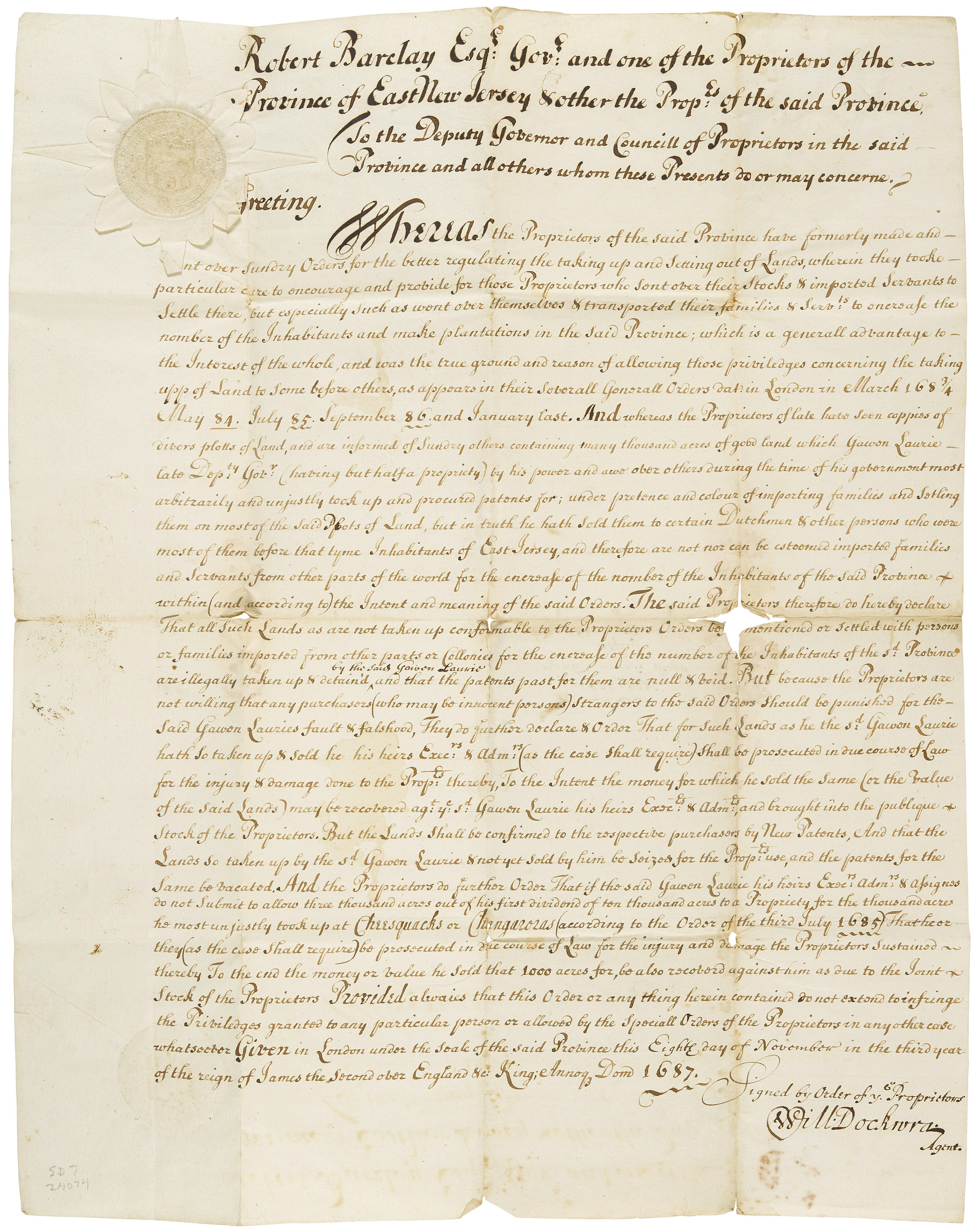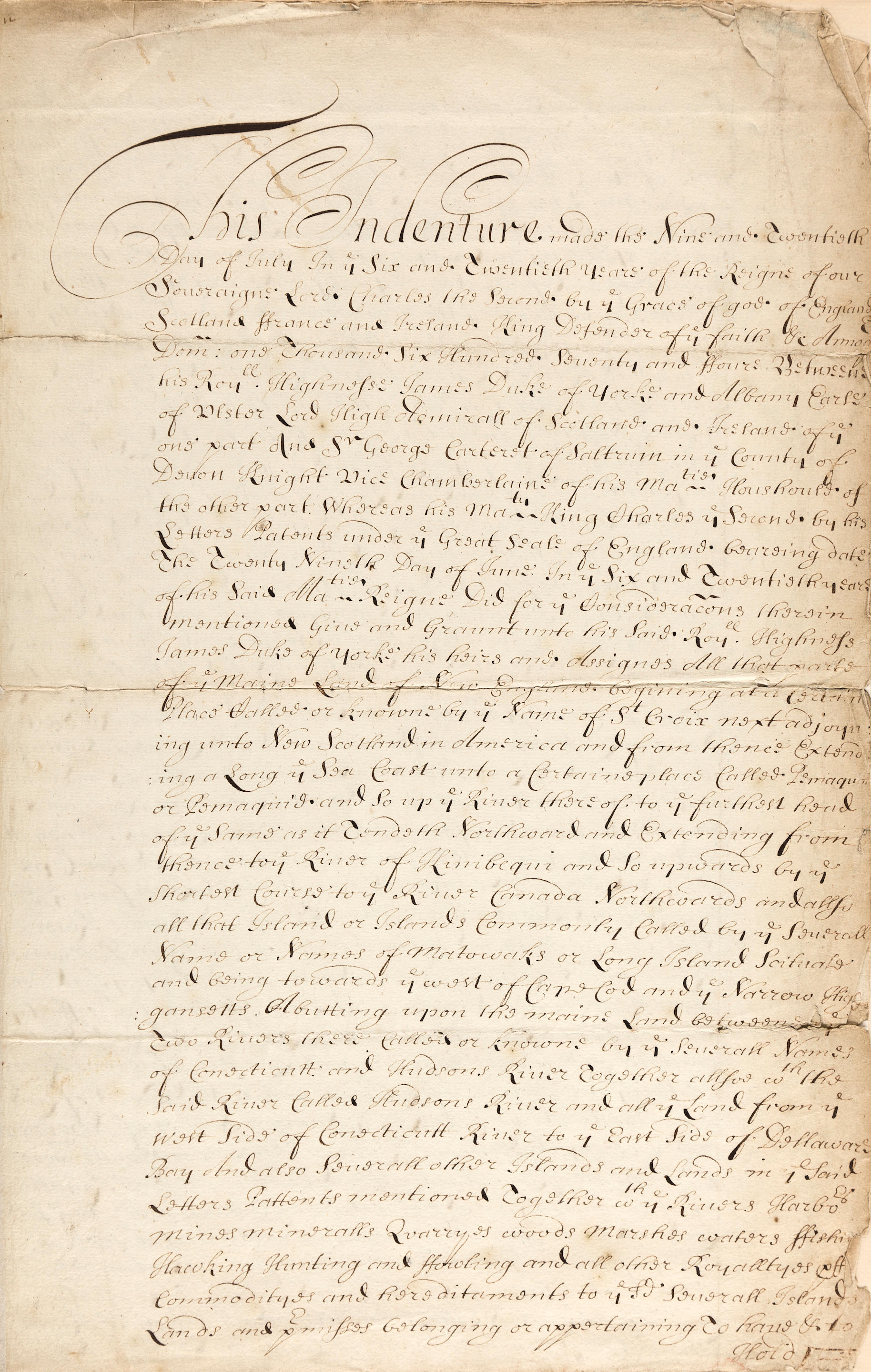EAST NEW JERSEY -- Document, deed of conveyance from Elizabeth Carteret, widow of Sir George Carteret, and his trustees to William Penn, Thomas Rudyard and ten others (the Twelve Proprietors) of the province of East New Jersey ('All that sayd Easterly part share and portion ... of y . sayd entire Tract of Land heretofore called Nova Caesarea or New Jersey which are now called or known by y . name of East New Jersey'), in consideration of the sum of three thousand and four hundred pounds, signed by Elizabeth Carteret and the seven trustees, n.p. [London], 2 February 1681[2] . Manuscript in brown ink on vellum, margins ruled in red, red wax seals (4), vellum tags; two sheets (660 x 830mm and 615 x 815mm), incomplete (lacking the 3rd sheet); the 1st sheet cropped at head with loss of initial letter and approximately 135 words, the 2nd similarly cropped with loss of text, the 3rd sheet cut away at foot; small holes, tears in inner margins, some wear and fading; together with a single vellum sheet from an indenture referring to the same subject, n.p., n.d. [1682] (700 x 810mm) , tears and holes with loss of text. The Conveyance is signed by Elizabeth Carteret, the Earl of Bath, Lord Crewe, Bernard Grenville, Robert Atkins, Edward Atkins, Thomas Pococke, Thomas Cremer, and endorsed on the verso 'and the sum of Three Thousand and ffour hundred pounds the consideracion in moneyes within paid and acknowledged to be received in the presence of [signed] Geo.Macy Ste. Mellichamp Harb . Springett Jun . Ben Wetton', and signed by two witnesses. The origins of East New Jersey lie in a grant made at the Restoration from the Duke of York (later King James II of England and VII of Scotland) to John, Lord Berkeley and Sir George Carteret of the territory of Nova Caesaria , or New Jersey, as a proprietary colony. In 1674 Berkeley, who had little interest, sold his share to a London Quaker group. The partition of the province was precipitated by the bankruptcy of one of them, Edward Byllinge. Carteret was persuaded to accept the Eastern part of the property, the line of partition being confirmed in the Quinpartite Deed of 1676, negotiated with William Penn (one of Byllinge's Quaker trustees), and others. The line of division was drawn from the East side of Little Egg harbour to the North West corner of the province, on the Delaware. The Eastern part, comprising 3,000 square miles and including seven townships, was the more populated area. The shuffling of proprietary rights was to continue after the death, in January 1680, of Sir George Carteret, who by his will devised all his 'plantations of New Jersey' to his widow and trustees, to be sold in order to pay his debts and legacies. They failed to sell it privately for between ¨5,000 and ¨10,000, and it was then put up for public auction, and acquired by the twelve men, mostly Quakers, to whom the province is conveyed in the present deed. The purchasers are named in the document as William Penn, Robert West Thomas Rudyard, Samuel Groome, Thomas Hart Richard Mew, Thomas Wilcox, Ambrose Rigge, John Heywood Hugh Hartshorne, Clement Plumstead and Thomas Cooper. Penn, Rudyard and Rigge were also the 'First Purchasers' of Pennsylvania, and some of the group had invested in West Jersey. The swift purchase of East Jersey by Penn and his associates, at a price well below the Carteret trustees' original expectations, was prompted by the grant in 1681 of Pennsylvania, which gave the Quakers ownership of the West bank of the Delaware, and their existing interest in West Jersey with control of the East bank. With the addition of the 'lower counties' (Delaware) which Penn obtained as a gift from James, Duke of York, before the end of 1682, the Quaker domain was thus spread over a wide territory, from the Hudson river to Delaware Bay. (2)
EAST NEW JERSEY -- Document, deed of conveyance from Elizabeth Carteret, widow of Sir George Carteret, and his trustees to William Penn, Thomas Rudyard and ten others (the Twelve Proprietors) of the province of East New Jersey ('All that sayd Easterly part share and portion ... of y . sayd entire Tract of Land heretofore called Nova Caesarea or New Jersey which are now called or known by y . name of East New Jersey'), in consideration of the sum of three thousand and four hundred pounds, signed by Elizabeth Carteret and the seven trustees, n.p. [London], 2 February 1681[2] . Manuscript in brown ink on vellum, margins ruled in red, red wax seals (4), vellum tags; two sheets (660 x 830mm and 615 x 815mm), incomplete (lacking the 3rd sheet); the 1st sheet cropped at head with loss of initial letter and approximately 135 words, the 2nd similarly cropped with loss of text, the 3rd sheet cut away at foot; small holes, tears in inner margins, some wear and fading; together with a single vellum sheet from an indenture referring to the same subject, n.p., n.d. [1682] (700 x 810mm) , tears and holes with loss of text. The Conveyance is signed by Elizabeth Carteret, the Earl of Bath, Lord Crewe, Bernard Grenville, Robert Atkins, Edward Atkins, Thomas Pococke, Thomas Cremer, and endorsed on the verso 'and the sum of Three Thousand and ffour hundred pounds the consideracion in moneyes within paid and acknowledged to be received in the presence of [signed] Geo.Macy Ste. Mellichamp Harb . Springett Jun . Ben Wetton', and signed by two witnesses. The origins of East New Jersey lie in a grant made at the Restoration from the Duke of York (later King James II of England and VII of Scotland) to John, Lord Berkeley and Sir George Carteret of the territory of Nova Caesaria , or New Jersey, as a proprietary colony. In 1674 Berkeley, who had little interest, sold his share to a London Quaker group. The partition of the province was precipitated by the bankruptcy of one of them, Edward Byllinge. Carteret was persuaded to accept the Eastern part of the property, the line of partition being confirmed in the Quinpartite Deed of 1676, negotiated with William Penn (one of Byllinge's Quaker trustees), and others. The line of division was drawn from the East side of Little Egg harbour to the North West corner of the province, on the Delaware. The Eastern part, comprising 3,000 square miles and including seven townships, was the more populated area. The shuffling of proprietary rights was to continue after the death, in January 1680, of Sir George Carteret, who by his will devised all his 'plantations of New Jersey' to his widow and trustees, to be sold in order to pay his debts and legacies. They failed to sell it privately for between ¨5,000 and ¨10,000, and it was then put up for public auction, and acquired by the twelve men, mostly Quakers, to whom the province is conveyed in the present deed. The purchasers are named in the document as William Penn, Robert West Thomas Rudyard, Samuel Groome, Thomas Hart Richard Mew, Thomas Wilcox, Ambrose Rigge, John Heywood Hugh Hartshorne, Clement Plumstead and Thomas Cooper. Penn, Rudyard and Rigge were also the 'First Purchasers' of Pennsylvania, and some of the group had invested in West Jersey. The swift purchase of East Jersey by Penn and his associates, at a price well below the Carteret trustees' original expectations, was prompted by the grant in 1681 of Pennsylvania, which gave the Quakers ownership of the West bank of the Delaware, and their existing interest in West Jersey with control of the East bank. With the addition of the 'lower counties' (Delaware) which Penn obtained as a gift from James, Duke of York, before the end of 1682, the Quaker domain was thus spread over a wide territory, from the Hudson river to Delaware Bay. (2)














Testen Sie LotSearch und seine Premium-Features 7 Tage - ohne Kosten!
Lassen Sie sich automatisch über neue Objekte in kommenden Auktionen benachrichtigen.
Suchauftrag anlegen